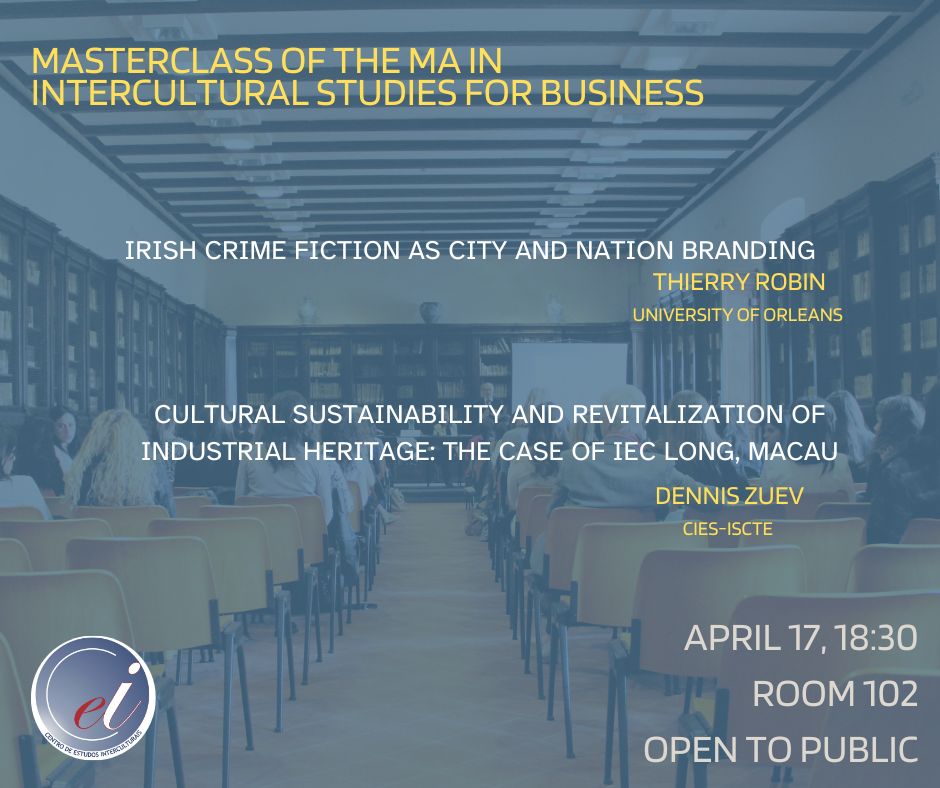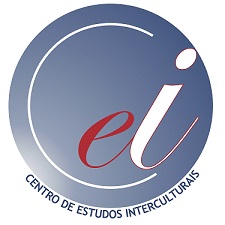
The Centre for Intercultural Studies invites the academic community to participate in the Masterclass of the Master in Intercultural Studies for Business, given by Thierry Robin (University of Orleans) and Dennis Zuev (CIES-ISCTE) , with the papers “Irish crime fiction as city and nation branding” and “Cultural Sustainability and Revitalization of Industrial Heritage: The case of Iec Long, Macau”.
The Masterclass will take place on Wednesday, April 17, at 18:30, in room 102 of ISCAP-P.PORTO and is open to the public.
Irish crime fiction as city and nation branding
By Thierry Robin, University of Orleans (UO)
McKinty an Irish writer now living in Colorado, believes that the new wave of Irish crime writing has coincided with the fact that America’s perception of Ireland has “changed radically in the last few years”. “Many of the old stereotypes are finally being laid to rest,” he says, “and Americans have discovered that Ireland is no longer the country of sheep, rain, Angela’s Ashes and The Quiet Man. “Crime writers embrace modernity and contemporary problems,” he says, “and Americans can’t help but notice in their visits to Dublin that Ireland has the youngest population in Europe and Dublin is a multi-cultural, twenty-first century city.”
Declan Burke, quoting from Adrian McKinty, (27 Jan 2008) https://crimealwayspays.blogspot.com/search?q=wave
According to Peter Doyle (1) who offers a concise but insightful definition of the concept of branding, “a successful brand is a name, symbol, design, or some combination, which identifies the ‘product’ of a particular organization as having a sustainable differential advantage”. Keith Dinnie qualifies this definition by applying it to cultural contexts stating that “Brands of course do not exist in a vacuum, and to be successful, they must co-exist effectively with the prevailing Zeitgeist. Popular culture and trends in society drive and influence strong brands” (14) Crime fiction naturally both taps into and informs popular culture. Now according to crime-writer Sophie Hannah, “It’s no mystery that crime is the biggest-selling genre in books”, which is partly true only. If you look closely at the US market, it is the romance novel genre which is the top-earning fiction genre, with 19 million units sold, in 2023 and $1.44 billion revenue in 12 months. But mystery thriller and crime genre books of fiction book sales make up the most popular fiction genre, with 32% of fiction book sales in 2023 in the US.
As Irish scholar Brian Cliff points out, crime fiction is also transnational in its readership and its settings. That is clear from the massive attention paid to Scandinavian crime fiction in Anglophone markets, or from the significant appetite for the ever-expanding Akashic Noir series of short story anthologies, from Beirut Noir to Belfast Noir to Buenos Aires Noir, collections that affirm the genre’s particular need for recognizably specific (and more often than not exoticized) settings. Ireland comes in gloriously as regards that promotion of authenticity, specificity and “differential advantage”. It is an anglophone country with a difference, which can be made the most on the crime fiction stage.
My talk will address the specific qualities which define Irish crime fiction and allow it to be alluring and attractive to diverse types of readerships by maintaining certain cultural ambiguities. 1. For instance, Irish crime fiction may rely on true crime and a strong palpable orientation towards nonfiction (as epitomized by Eoin McNamee’s successful Blue Trilogy shows). 2. Northern Irish crime fiction is alternately branded or rebranded as Irish or British depending on which market it is addressing, sometimes going as far as to change titles to reinforce or erase its local flavour. Stuart Neville’s 2009 hit The Twelve was rebranded as The Ghosts of Belfast in 2012 when it was launched into the US market. 3. Irish crime fiction, may read more often than not as multigeneric and borrows from different traditions which make it alluring to buyers, readers keen on gothic, fantastic, historical fictions, or chick lit not to mention young adult’s literatures to name but a few genres. To cut a long story short : Ireland itself offers a multiplicity of strategic brandings.
They range from the innocent bucolic rural so-called emerald island to post-Celtic Tiger wildly deregulated Ireland.com, or Ireland 2.0 serving as the headquarters of GAFAM big players (namely : Google (Alphabet), Apple, Facebook (Meta), Amazon et Microsoft) in Europe. Ireland is in turn depicted in postcolonial terms as rebellious anti-imperialistic in a romantic manner or arrogantly globalized and digitalized, having sold its soul to big business, as in Alan Glynn’s corporate technothrillers –see The Dark Fields or Limitless (2001/2011) where criminals are essentially white collars. Traces of this economic dilemma are also to be found throughout Brian McGilloway’s post Troubles Ben Devlin series, notably Blood Ties (2021). It may also be strongly territorialized and restricted to one island or its 26+6 Southern and Northern counties or on the contrary transnational, deterritorialized and diasporic. This talk aims at identifying the various strengths or assets of Ireland as a brand in crime fiction, where literary heavyweights like Tana French or John Banville aka Benjamin Black are to be reckoned with.
Thierry Robin, University of Orléans, France –Athena European University.
Thierry Robin is a professor of anglophone studies at the University of Orléans. In addition to his work on media and translation studies, his research focuses on contemporary Irish studies and the connections between ideology, epistemology and the concept of reality, notably through the genres of satire and crime fiction. He has written numerous articles about Irish writers including Flann O’Brien, Samuel Beckett, Anne Enright, Dermot Healy and John Banville, amongst others. He has also published a book devoted to the study of Flann O’Brien’s novels, entitled Flann O’Brien, Un voyageur au bout du langage (PUR, 2008) and coedited a collection of essays bearing on political ideology, Political Ideology in Ireland from the Enlightenment to the Present, (CSP, 2009). Polar et émeraude noire: portraits of contemporary Ireland –his monograph on Irish crime fiction–, was published by Rennes University Press (PUR) in early April 2024. He is currently editing -along with Prof K. FISHER and E. GALLET- a collection of essays on the decade of centenaries [2012-2023] in Ireland, which should be published by Caen Normandy University press (PUC) in 2025.
Cultural
Sustainability and Revitalization of Industrial Heritage: The case of Iec Long,
Macau
by Dennis Zuev, CIES-ISCTE, Lisboa
Macau is a Special Administrative Region (SAR) located in the south of the People’s Republic of China (PRC). Settled by the Portuguese it was the last European colony in Asia. Over the centuries as a maritime city Macau saw its fortunes coming as the trade boomed in the 16-17th centuries, however with the establishment of Hong Kong as a port city the importance of Macau decreased. The authorities resorted to gaming and tourism as key sources of tax revenues, however manufacturing continued in Macau until very recently and consisted of textile manufacturing, matchsticks, incense, firecracker production and ship-building. As gaming boomed in Macau in the 2000s, it became the Las Vegas of Asia, a territory with one of the highest per capita incomes in the world.
As the pandemic hit China and the rest of the world, Macau was isolated, gaming revenues declined temporarily and the Macau authorities decided to diversify its offer of tourist attractions with investments in cultural and heritage attractions. Although Macau has already been recognised as a UNESCO heritage site with a well-preserved historic core since 2005, two new attractions were developed to help reposition Macau as a city with a rich cultural history. The two new sites that opened in 2023 were the long abandoned Iec Long firecracker factory and the dilapidated Lai Zhi Vun shipyards.
Both sites are unique, as they blend an interface with nature (green space or river, mangroves) and a public space with displays of how the work activities were performed on site. Both sites also narrate different stories about Macau and its past, thus connecting the visitors with the past in the present. The sites are unique as many residents still have memories related to these locations, where they worked or members of their family were occupied.
To the western eye the sites are seen as being quite authentic, as they were literally unchanged, but to the locals and tourists they may seem to be of limited use, as they do not provide any additional participative activities and are too static. In this presentation I use qualitative data from the interviews as well as visual analysis of the sites to provide a “thick description” of Iec Long factory as an open-air museums and reflect on the cultural and political significance of the industrial historical geographies of Macau. Additionally, I emphasize the importance of discussing heritage and its preservation within the framework of cultural sustainability, which needs to be analytically separated from economic, social and environmental pillars of sustainability. Culture is thus an important domain that needs conceptualization in terms of sustainable development goals.
Dennis Zuev
Principal Researcher, CIES-ISCTE, Lisboa, Portugal
Coordinator of the Research Lab for Cultural Sustainability, University of St. Joseph, Macau
Affiliated Researcher, Instituto do Oriente, ISCSP, UL, Lisboa
Member of Urban Transitions Hub, ICS, UL, Lisboa

